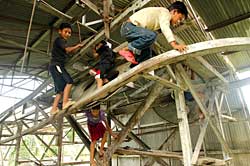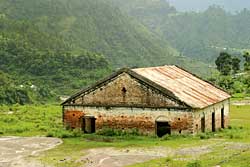 Crossing Chitlang Pass to get to Kathmandu from the tarai in 1950, French mountaineer Maurice Herzog looked up in surprise. 'I saw huge cables going right across a valley,' he wrote in his epic adventure book, Annapurna. 'I wondered if it could be a cable railway. Indeed it was, the longest in the world, measuring nearly 19 miles. It provisioned Kathmandu and the surrounding neighbourhood, a population of some 150,000 people.'
Crossing Chitlang Pass to get to Kathmandu from the tarai in 1950, French mountaineer Maurice Herzog looked up in surprise. 'I saw huge cables going right across a valley,' he wrote in his epic adventure book, Annapurna. 'I wondered if it could be a cable railway. Indeed it was, the longest in the world, measuring nearly 19 miles. It provisioned Kathmandu and the surrounding neighbourhood, a population of some 150,000 people.'
Herzog was wrong about the world record. In 1919, Ropeways Ltd London had already constructed a 73.3km ropeway in Colombia. Still, the nearly 31km long Dhorsing-Matatirtha ropeway was an impressive piece of engineering, and it was the second ropeway built in Nepal. The first was the Swayambhunath Ropeway, a 4km cable system from a mine in Halchowk to Lainchaur. Rana Prime Minister Chandra Sumshere commissioned it in 1924 to cater to Kathmandu's palace-building spree that was in full swing at the time.  The ropeway from Dhorsing near Bhimphedi to Matatirtha in the Valley had to cross two passes over 2,600m. During construction, English engineers found villages fleeing because rumours spread that children would be sacrificed at the foot of the trestles before it went into operation. The Tri Chandra Nepal Tara Ropeway was finally opened in 1927 with a capacity of eight tons per hour. Indian freight was transported from Raxaul to Amlekhgunj by train-that 48km railway was another one Chandra Sumshere's ideas. Cargo was taken to Dhorsing by lorry and then the ropeway hauled it to Matatirtha.
The ropeway from Dhorsing near Bhimphedi to Matatirtha in the Valley had to cross two passes over 2,600m. During construction, English engineers found villages fleeing because rumours spread that children would be sacrificed at the foot of the trestles before it went into operation. The Tri Chandra Nepal Tara Ropeway was finally opened in 1927 with a capacity of eight tons per hour. Indian freight was transported from Raxaul to Amlekhgunj by train-that 48km railway was another one Chandra Sumshere's ideas. Cargo was taken to Dhorsing by lorry and then the ropeway hauled it to Matatirtha.
"I remember it going up," says Krishna Prasad Paniru in Dhorsing. "We became a bustling village after that." He shows us the remnants of the foundation of the ropeway's very first tower in the middle of a corn field.
Two Rana-era godowns still remain, half-buried by the flashfloods that swept away the bazar. After the Dhorsing ropeway decayed and died, the Americans built an even longer one (see review). Krishna Prasad worked on that ropeway construction and was paid Rs 3 a day. "We carried up all the steel parts and assembled the towers and terminals on the spot," he recalls. "We had to climb up and down steep ridges in a long line to haul the cable in position," he adds, pointing to a question-mark shaped carrier still hanging on cables traversing the high above the valley.  The American-built 42.3km Nepal Ropeway started in Hetauda and ferried material to Teku, crossing what is now the Ring Road at Balkhu. Although the Tribhuban Highway opened for traffic in 1956, the Americans helped the Nepali government with the $6.4 million project because it would slash transport time, save cost and not be affected by the monsoon.
The American-built 42.3km Nepal Ropeway started in Hetauda and ferried material to Teku, crossing what is now the Ring Road at Balkhu. Although the Tribhuban Highway opened for traffic in 1956, the Americans helped the Nepali government with the $6.4 million project because it would slash transport time, save cost and not be affected by the monsoon.
The bi-cable system (two continuous stationary track cables and two hauling ropes) was supported by 280 steel towers. It consisted of seven sections, with big terminals on each end to regulate carrier movement. Carriers could make the roundtrip from Hetauda to Kathmandu and back in 4 hours and 12 minutes, hauling 22 tons of cargo a day.
"It was a great system, but difficult to operate," recalls Krishna Prasad, who continued to work for the ropeways for 14 years. "My terminal had 25 staff to push the incoming carriers to the traction rope of the next section. Every 90 seconds a carrier would arrive. It was extremely important to have good communication. If a section broke down we had to shut down the other ones immediately to prevent massive collisions."  After the Hetauda-Kathmandu leg was completed, almost two decades passed before private groups and the European Union introduced new cable railway systems in Nepal. The Manakamana Cable Car, which, since 1998, has carried people to a popular pilgrimage site from the Mahendra Highway, has proven that a well managed system can be profitable and deliver excellent services.
After the Hetauda-Kathmandu leg was completed, almost two decades passed before private groups and the European Union introduced new cable railway systems in Nepal. The Manakamana Cable Car, which, since 1998, has carried people to a popular pilgrimage site from the Mahendra Highway, has proven that a well managed system can be profitable and deliver excellent services.
Unfortunately, Nepal Ropeway awaited a different fate. Mismanagement and apathy took their toll and the ropeway stopped running in 1994. In Hetauda, goats graze in the terminal compound. On the other side of the mountain, in Dhaksi, a man who is living directly underneath the ropeway says the buzzing sound he was so familiar with stopped eight years ago. Along the route, pieces of cable have come down, the terminals are rusted and crumbling and useful steel parts have been stolen, including six complete towers.  Experts cite many reasons for the collapse of Nepal Ropeway. The open style carriages made pilferage easy. A woman in Dhaksi tells us that people used long bamboo poles to push sacks of foodgrains out of the carriers as they passed overhead. There is also a conspiracy theory which says truck owners sabotaged the ropeway. But the biggest problem was institutional: the ropeway was operated by the Nepal Transport Corporation (NTC) under the Ministry of Works and Transport, which were primarily concerned with building roads.
Experts cite many reasons for the collapse of Nepal Ropeway. The open style carriages made pilferage easy. A woman in Dhaksi tells us that people used long bamboo poles to push sacks of foodgrains out of the carriers as they passed overhead. There is also a conspiracy theory which says truck owners sabotaged the ropeway. But the biggest problem was institutional: the ropeway was operated by the Nepal Transport Corporation (NTC) under the Ministry of Works and Transport, which were primarily concerned with building roads.
Maintenance is vital for a ropeway, because the shutdown for one single day results in huge revenue losses and is disastrous for its reputation. The budget allocated to maintain Nepal Ropeway was not enough. It was overstaffed and suffered poor capacity utilisation. Although several studies showed hauling freight by ropeway was actually cheaper than transporting it by road, even government corporations like National Trading used trucks instead of the ropeway to get their supplies to Kathmandu.
In 1993, Nepal Ropeway proved its value for the last time after floods washed away parts of both the Tribhuban and Prithbi highways, cutting Kathmandu off. The ropeway had lost two towers along the Rapti river bank, but with the help of the army they were restored in 24 days and the ropeway could supply Kathmandu with vegetables and other food products.
But after the roads reopened, the promises for better government support evaporated and things went downhill fast. The NTC was dissolved two years ago and the ropeway has been shifted to the Ministry of Labour and Transport, but nobody really feels responsible anymore. Nepali cable car expert, Resham Raj Dhakal, says with an air of finality: "It is dead."
Even so, Grade Eight students all over Nepal still have to memorise details about a glorious 42km pioneering ropeway connecting Hetauda to Kathmandu 'in operation at present' (Ekta Books, Our Social Studies, 2004 revised edition).


